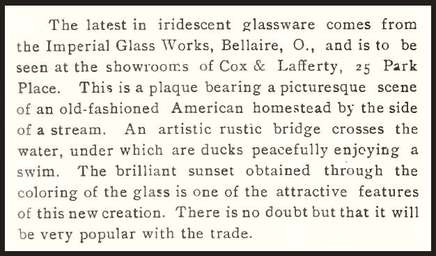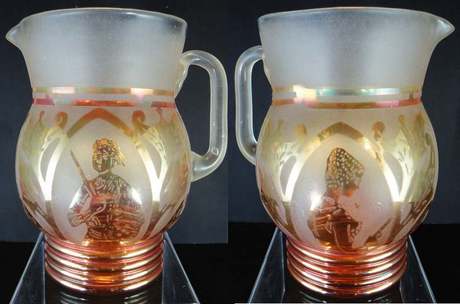NetworK ezine Issue 22. March 2017
Totally Devoted to Carnival Glass
|
Sell It To Me! Bargain Basements, Mail Order and Department Stores – we’re familiar with how Carnival Glass was marketed and sold through these outlets in the early 1900s. But what other kinds of stores and shops did everyday folk get their beautiful iridescent glassware from? They bought it in general stores, drug stores, grocery stores, furniture stores, five & ten cent stores and more! They even bought it in ironmongers (hardware stores) where it was stacked up next to the mops, buckets, timber, tools and even rifles and guns. |
Above: black amethyst (“dark”) and marigold Kingfisher bowls,
and a “dark” Kookaburra bowl. Made by Crown Crystal, Australia. |
Shown below - the "Price pulverizer" - it was a wonderful price cutting promo for an ironmongers store in Parramatta (Sydney, Australia) in 1923. The imagery of the "Price Pulverizer" steamroller flattening prices is brilliant! Among the garden tools and household implements, the busy shopper could also have found “De Lustre and Irid Salads” – Carnival Glass! “De Lustre” was Crown Crystal’s name for their “dark” (black amethyst) Carnival, and their marigold was referred to as “Iridescent”, so the selection at Irwin’s store in 1923 would likely have included Kingfisher bowls, as shown above.
|
Fenton's Peacock Tail berry set in amethyst.
Courtesy of Seeck Auctions. In 1910, one drugstore in Oregon showcased an entire range of Fenton’s Carnival, including a full Peacock Tail berry set, like the one shown above. In a startling coincidence, also in 1910, another drugstore (pharmacy or chemist shop) many thousands of miles away, offered a single Peacock Tail bowl for the same price that the Oregon store had for the full berry set. |
We have a major new Three Part feature that includes many more pictures and lots of fascinating old ads for Carnival Glass from all around the world: here's the link to "Sell Me Some Carnival Glass".
|
NUArt Beauties
It’s not hard to guess, from the detailed description in the 1912 text above, what Carnival pattern it refers to – it is, of course, Imperial’s Homestead (NUART Homestead). Note the observation in the journal: “the brilliant sunset obtained through the coloring of the glass is one of the attractive features of this new creation”. On most of these beautiful plates, this “sunset” effect is apparent – the trees and buildings appearing to be in relief against the vibrant sky behind. How did they achieve this startling and brilliant effect? It’s all because of the thickness of the glass! The glass is much thicker where the moulded patterns of the trees and buildings are – and less thick on the flatter parts where the sky, stream and pond are. The iridescence naturally appears different on the thinner/thicker parts of the glass – and thus the clever sunset effect is achieved. |
Above: extract from the June 1912, Crockery and Glass Journal
|
Another interesting observation about the Homestead plate and its “sister” pattern, the NUART Chrysanthemum, is revealed in a 1915 Imperial catalogue. They were intended as practical items (cake plates) but they were also deliberately marketed as wall decorations.
|
It's also interesting to compare the actual designs on the Carnival plates with the images that are in the Imperial catalogue: they are different. The catalogue image is actually the inverse of the way the design appears in the glass. On the right, we compare the Homestead catalogue image with one that we "flipped" (with image editing software) - the "flipped version is the way the design actually appears on the glass. This inadvertent "flipping" is also found in other catalogue illustrations (especially Imperial), which has caused some collectors to ask if they have a "variant" because their piece differs from the catalogue image. The full catalogue page is impressive and has a few surprises! See it here: Imperial's NUART Homestead and Chrysanthemum plates. |
|
Rococo Waves
This stunning oil lamp in rich marigold Carnival was found by Dick and Sherry Betker. It is the twin to a smoke version that was found (and named) by the late Frank Horn some years back. Visit our Collectors Facts to see more wonderful images of these lamps. Rococo Waves oil lamp.
Photo courtesy Dick and Sherry. |
Warriors
This fascinating, Indian water pitcher was also found by Dick and Sherry. Close study of the marigold pattern on the frosted background reveals details of an intriguing design. On one side there is a man holding a sword and a shield, while the other side shows a woman holding what appears to be a revolver. Visit the Collectors Facts on Ringed Base Water Sets to see more of this astonishing design. Warriors pitcher, made in India (maker unknown).
Courtesy Dick and Sherry. |
|
Collectors Facts
There are around 150 unusual and often rare, puzzling and mysterious patterns shown in the unique Collectors Facts series on our website. Here’s a selection of some of them: Janovals – could this curious piece be from Sowerby? Royalty – see the original Patent and discover our revelations Mary Ann – discover how to distinguish between old and new Prism and Pleats – a challenging geometric Hexagon and Cane – see the confusion around this Imperial geometric Tartan – did you know there were variations? Tornado vases – in many different versions Click on the picture on the right to visit our Collectors Facts Homepage. |
|
When is a Plate a Chop Plate?
It sounds like a riddle that you might get inside a Christmas cracker, but why is a large Carnival plate called a "chop plate"? In Carnival collecting, a plate over 10” or 11” is considered a chop plate (for example, the two Imperial NUART plates shown above). But how did it get that name? One school of thought says it's simply a large serving plate for chops or other meats. But delve a little deeper and you'll come across references to chop plate being another name for a charger, underplate or service plate. These are the large plates that go underneath regular dinner plates in “fine dining”. You would not eat off a charger, it is simply to keep the main plate (which is likely to be hot) off the table. The charger / chop plate wouldn't have been made from material that was designed for food. |
Above: two Fenton Persian Medallion plates. On the left is the 9” size, and the one on the right is the 10.5" chop plate. Note: there are two smaller sizes of plates in this pattern.
|
And we have a theory where the term chop plate might have come from ... a "chapa plate" is an old term for a thin plate of metal. Could such a thin metal plate have been used as an under plate / charger? And the term chapa plate may have changed over the years to chop plate, meaning an oversized plate for serving.
And we have a theory where the term chop plate might have come from ... a "chapa plate" is an old term for a thin plate of metal. Could such a thin metal plate have been used as an under plate / charger? And the term chapa plate may have changed over the years to chop plate, meaning an oversized plate for serving.
We invite you and your friends to join us all on NetworK's fast growing and very active Facebook Group - Carnival Glass NetworK. If you have missed any of the previous 27 issues of NetworK and NetworK Specials, they are on our Back Issues page.













